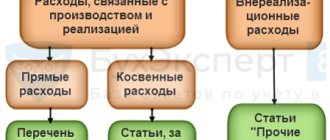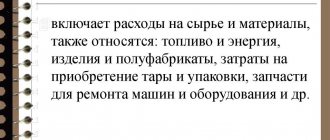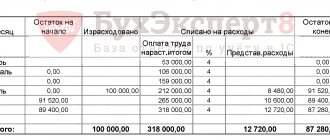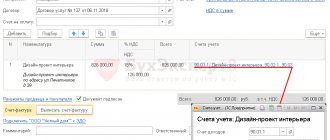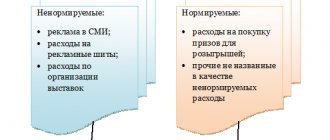Basic and overhead costs
Based on the economic role in the production process, costs are divided into basic and overhead.
The main costs are those directly related to the production (technological) process of manufacturing products, performing work or providing services. In other words, the main costs include expended resources, the consumption of which is associated with the production of products (works, services), - for example, materials, wages of production workers, depreciation of fixed assets, etc.
Overheads are recognized as costs that arise in connection with the organization, maintenance and management of production.
For example, general production and general economic expenses - maintenance of the management apparatus, depreciation and repair of fixed assets for workshop or general plant purposes, taxes, costs of recruiting and training personnel, etc.
Structure of direct and overhead costs by item
Direct costs most often consist of the following costs:
- for materials necessary to create specific products;
- salaries of personnel directly involved in the creation of these products;
- insurance premiums accrued on the salaries of personnel creating products.
The composition of overhead costs, usually divided into 2 main types, is much wider and is characterized by significant similarity in the lists that occur for general production and general business costs. These lists typically include expenses:
- for remuneration of management and other personnel of a production or general business unit;
- insurance premiums accrued to pay for the labor of these personnel;
- material support for the current work of departments (low-value equipment, office and household supplies, consumables for low-value equipment);
- depreciation of used fixed assets;
- maintenance and operation of fixed assets, including their routine maintenance, provision of necessary resources (fuel and lubricants, replacement parts, electricity, water, heat, gas), current and major repairs;
- property rental;
- property and personnel insurance;
- obtaining permits;
- ensuring the quality of products;
- labor protection;
- information, consulting and legal support;
- business trips;
- entertainment events;
- personnel selection.
Read more about the composition of general business expenses in the article “Account 26 in accounting (nuances).”
Due to the impossibility of direct correlation with specific types of products created (objects), overhead costs are allocated. The organization chooses the basis for this distribution independently. This may be one type of direct costs (materials or labor) or their total amount.
Direct and indirect costs
Classification of costs according to the method of their inclusion in the cost of products, works and services into direct and indirect. It is this classification that determines the order in which costs are reflected in certain synthetic accounts, subaccounts and analytical accounts.
Direct costs are those that can be directly, directly and economically attributed to a specific type of product or to a specific batch of products (work performed or services provided). In practice, this category includes:
- direct materials costs (that is, raw materials and basic materials used in the production of products);
- direct labor costs (payment of personnel involved in the production of specific types of products).
However, if an enterprise produces only one type of product or provides only one type of service, all production costs will automatically be direct.
Indirect costs are those that cannot be directly, directly and economically attributed to a specific product, so they should first be collected separately (on a separate account), and then - at the end of the month - distributed by type of product (work performed, services provided) based on the chosen techniques.
Among production costs, indirect costs include auxiliary materials and components, expenses for wages of auxiliary workers, adjusters, repairmen, vacation pay, extra pay for overtime, payment for downtime, costs for maintaining workshop equipment and buildings, property insurance, etc. d.
Let us emphasize that indirect costs are associated simultaneously with the manufacture of several types of products, and they either cannot be “attributed” to a specific type of product, or in principle this is possible, but it is impractical due to the insignificance of the amount of this type of costs and the difficulty of accurately determining the part of them that accounts for for each type of product.
In practice, the separation of direct and indirect costs is very important for organizing the work of accounting in terms of cost accounting. Direct costs should be based on primary documents plus possibly additional calculations, as, for example, if the same type of raw material is used to produce several types of products in one division and it is impossible to provide accurate primary accounting of exactly how much of this raw material is spent on each from types of products, be included directly in the cost price of each type of product, formed by the debit of account 20 “Main production”. But indirect costs are collected on separate accounts - for example, shop expenses during the month are debited to account 25 “General production expenses”.
If we talk about the relationship between the two classifications considered, we can note the following:
- all direct costs are basic (after all, they are necessary for the production of specific types of products);
- overhead costs are always indirect;
- Some types of basic expenses, from the point of view of the order of their inclusion in the cost price, are not direct, but indirect - such as, for example, the amount of depreciation of fixed assets used in the production of several types of products.
Direct and overhead (indirect) costs/expenses
When dividing items into direct and invoice (indirect) (see Fig. 1
), it is necessary to indicate the object in respect of which such classification is carried out. This means that one company may have several classifications of costs/costs for direct and overhead (indirect) depending on the objects.
Thus, direct costs/expenses
– these are expenses/expenses that are directly related to a specific object. That is, to attribute these costs/expenses to a specific object, you do not need to apply any procedure for allocating costs/expenses.
Overhead (indirect) costs/costs
– these are costs/expenses that cannot be directly attributed to a specific object.
The purpose of this classification (direct/invoice), in general, is clear - to calculate the economic efficiency of certain objects. Such objects can be, for example, products or services, divisions, sales channels, regions in which the company operates, etc.
True, with such a breakdown, the question very often arises of how to allocate overhead (indirect) costs to objects. In fact, before asking such a question, you first need to be clear about the purpose of such separation.
There is a practical sense of allocating costs/expenses to objects only if after this operation it is possible to make decisions that lead to an increase in the efficiency of the company, including a reduction in overhead costs.
Otherwise, posting costs/expenses is a waste of time. In addition, such separation can lead to negative consequences when, based on the data obtained, incorrect decisions are made, leading to a deterioration in the company’s performance.
More information about overhead (indirect) costs/costs can be found in the article “Overhead/Costs”.
Product costs, period costs
This classification is very important from the point of view of management accounting, since it is the only one used in Western countries, where many of the management accounting methods used today were developed, and such a classification is usually required in both management and financial accounting.
Figure 2. Classification of costs in management accounting
Product costs (production costs) are considered only those costs that should be included in the cost of production, at which it should be accounted for in workshops and warehouses, and if it remains unsold, reflected in the balance sheet. These are “inventory-intensive” costs directly related to the manufacture of products and, therefore, subject to accounting as part of its cost.
In practice, this category of costs includes:
- raw materials and basic materials;
- remuneration of personnel involved in the production of specific types of products;
- general production costs (production overhead), including: auxiliary materials and components; indirect labor costs (salaries of support workers and repairmen, additional payments for overtime, vacation pay, etc.); other expenses - maintenance of workshop buildings, depreciation and insurance of workshop property, etc.
Period costs (periodic expenses) include those types of costs, the size of which does not depend on production volumes, but rather on the duration of the period. In practice, they are presented in two articles:
- commercial expenses – expenses associated with sales and deliveries of products (goods, works, services);
- general and administrative expenses are the costs of managing the enterprise as a whole (in Russian practice they are called “general business expenses”).
Such costs are not included in the cost of finished products, because they are not directly related to the production process, therefore they are always attributed to the period during which they were produced, and are never attributed to the balances of finished products.
When applying this classification, the full cost of products sold is formed in the following order.
Figure 3. Formation of cost in classical management accounting
If we apply this classification to domestic practice, guided by the Russian Chart of Accounts, it is necessary to organize cost accounting as follows:
1) in terms of product costs:
- direct material and labor costs are collected directly on account 20 “Main production” (according to subaccounts and analytical accounts for each type of product, work, service);
- General production expenses during the reporting period are collected in a separate account (according to the Russian Chart of Accounts, account 25 “General production expenses” is used for these purposes), and at the end of the period they are distributed and written off to account 20 “Main production” (by type of product, work, service );
- as a result, all costs recorded on the debit of account 20 “Main production” for a certain period represent total production costs, which may relate to manufactured products, forming the production cost of finished products (or to work performed, services provided, forming their cost accordingly), or may relate to work in progress balances, if any;
2) in terms of period costs:
- one must proceed from the postulate that periodic expenses are always attributed to the month, quarter or year during which they were incurred, that is, at the end of the period they are completely written off to reduce the financial result (profit), and they are never attributed to the balance of finished products on warehouse and work in progress;
- This means that they must be collected in accounts designated for these purposes (in Russia these are accounts 26 “General business expenses” and 44 “Sales expenses”), and at the end of each month the entire amount of expenses collected for the month must be written off from the credit of these accounts to the debit of the account 90 "Sales".
Please note that this option is permitted by current Russian legislation (in particular, PBU 10/99 “Organizational Expenses” and the Instructions for the Application of the Chart of Accounts). So every manager and accountant can implement this methodology into the practice of their organization.
However, in Russia, unlike IFRS and the accounting requirements of many foreign countries, this is not the only permitted option.
Thus, account 44 “Sales expenses” in Russian practice may not be closed completely “month to month”; depending on the accounting policy of the organization, a carryover debit balance may be formed on this account - for example, in terms of costs for packaging and transportation of shipped products, if it has not yet become the property of the buyer, or in terms of transportation costs in trade organizations (if part of the goods remained unsold at the end of the month).
And we can close account 26 “General business expenses” not to account 90 “Sales”, but to account 20 “Main production” (as well as 23 “Auxiliary production” and 29 “Service production and farms”, if their products, work and services are sold externally). It was this option that was used until the early nineties, and it was not canceled or completely replaced by a new option using account 90 “Sales”.
The logic of this application of the 26th account, which involves the inclusion of general business expenses in the cost of specific types of manufactured products, works, services (including for the purpose of estimating the balances of unsold products), is based on the traditional approach, according to which in domestic practice, production costs and Today, in addition to material costs, labor costs and general production expenses, many also include general business expenses (and, accordingly, non-production costs include the costs of selling products, as well as maintaining social facilities).
With this approach, the meaning put into the concept of “production cost” also changes:
- a Western accountant or manager views this type of cost as the sum of “product costs”, and in his view management costs cannot be included in production costs;
- In domestic practice, to this day, there are often not two (production and full), but three types of cost - shop, production and full, while:
- shop cost is considered to be precisely the amount of “product costs” (that is, in our country shop cost is what Western experts call production cost);
- Production cost in Russia is often understood as the sum of shop cost and general business expenses, that is, in addition to “product costs” (direct and general production expenses), it also includes management expenses, which Western experts clearly classify as “period costs”, subject to accounting only in full cost and never included in production costs;
- the concept of the full cost of goods sold is conceptually the same in both systems, although its value, other things being equal, may not coincide (if there are balances of unsold products, because then for a Russian accountant, part of the management costs may “settle” in the balance sheet in the value of the balances of finished products, and For a Western accountant, the entire amount of management expenses will be attributed month to month to the reduction of profits).
Composition of overhead costs
The definition of overhead costs is used to calculate the value of all additional costs of the organization. That is, costs that are not involved in production, but ensure the successful operation of the enterprise, including technological processes. Like direct costs, overhead costs must be included in the cost of manufactured products - the calculation is performed not by allocating the entire amount to the price, but using proportional distribution. How to calculate the percentage of overhead costs using the formula will be discussed below.
Overhead costs typically include:
- Carrying out routine repairs of used equipment, machines, premises, structures, buildings, vehicles and other objects.
- Settlements with enterprise administration personnel, management specialists, personnel officers and other employees not related to the main production personnel. Remuneration of service personnel; conducting training and advanced training for such employees.
- Deductions for insurance premiums in terms of payments to employees from clause 2 for compulsory health insurance, compulsory medical insurance and compulsory social insurance, injuries.
- Costs for maintaining warehouses, office premises and buildings, including payment of utility bills for electricity, heat and water supply, communication and Internet services.
- Costs of paying rent for office, warehouse, retail premises and buildings.
- Costs of maintaining company-owned transport facilities.
- Costs for carrying out all kinds of PR events, participation in fairs, expositions, exhibitions, advertising costs.
- Costs incurred due to defects in manufactured products and production downtime.
- Main production maintenance costs.
- Costs of opening credit lines, paying interest on obligations, related expenses, leasing payments.
- Other costs.
Production costs and production costs
The exact composition of overhead costs for each organization is determined individually, taking into account the specifics of production and the nuances of the industry. The main thing that an accountant needs to remember when developing a working collection of overhead costs (OOP) is that such costs cannot be directly related to the calculation of the cost of GP (finished goods). However, in some cases it is quite difficult to make a clear distinction between what basic and overhead costs exist in an organization. In this case, it is recommended to focus on the specifics of the situation and, depending on the specifics of the products being manufactured, include HP in direct or additional costs.
Note! At the legislative level, an exact list of overhead costs taken into account is fixed only in medicine and the construction industry. Companies operating in other industries should independently outline the circle of HP workers and consolidate their composition in the applied accounting policies to justify expenses and methods for calculating the cost of products or services (work).
Aggregated structure of overhead costs:
- Commercial – includes the so-called trade and logistics costs associated with the sale of GPs or services to consumers. A striking example is the cost of loading and unloading operations, packaging and packaging of products, conducting market research, advertising services, etc.
- General economic costs - consist of the organization’s costs of managing and servicing those workshops and other divisions that may be part of both the main production and auxiliary ones. For example, these are salaries of management personnel, depreciation of fixed assets for administrative purposes, consulting services (auditing, accounting), rental of office space, etc.
- General production costs - represent the total costs of organization, subsequent maintenance, as well as ongoing maintenance of the types of production available at the enterprise - from the main one to auxiliary and servicing. These are expenses such as equipment repairs, vehicle maintenance, depreciation of operating systems, utility costs, remuneration for service personnel, insurance payments, etc.
General production and general business overhead costs when calculating are subject to proportional attribution to the cost price of the enterprise. How to properly allocate overhead costs? Features of calculations in the next subsection.
Total and specific costs
First of all, we note that costs can be cumulative and specific - depending on the volume they are calculated for (for the entire set of products, for the entire batch of products or per unit of production).
Cumulative expenses are expenses calculated for the entire output of an enterprise or for a separate batch of products. In other words, these are the total, total costs for a certain amount of products of the same type or even for a certain volume of products of different assortments.
Specific costs are costs calculated per unit of production.
Accordingly, the cost can be calculated per unit of product or for the entire batch, or we can talk about a general cost indicator for all types of products, works, and services for a certain period.
Depending on the specific management problem to be solved, in some cases it is important to know the amount of total costs, and in others it is important to have detailed information about specific costs (for example, when making decisions in the field of pricing and assortment policy).
Variable and fixed costs
Depending on how costs react to changes in the organization’s business activity - to an increase or decrease in production volumes - they can be divided into variable and constant.
Variable costs increase or decrease in proportion to changes in production volume, that is, they depend on the business activity of the organization. They, in turn, can be divided into:
- production variable costs: direct materials, direct labor, as well as part of overhead costs, such as the cost of auxiliary materials;
- non-production variable costs (costs of packaging and transportation of finished products, commissions to intermediaries for the sale of goods, etc.).
Fixed costs in total do not depend on the volume of production and remain unchanged during the reporting period. Examples of fixed costs are rent, depreciation of fixed assets, advertising costs, security costs, etc.
The point is that the total amount of fixed expenses usually does not depend on exactly how much and what kind of products the company produces in a given month. For example, if a company rented premises for a production workshop or retail outlet, it will have to pay the agreed rent every month, even if nothing is produced or sold at all in one of the months, but, on the other hand, if this premises will be operated around the clock, and not eight hours a day, the rent will not be higher. The situation is similar when advertising is given - of course, the goal is to sell more products, but the amount of advertising costs (for example, the cost of advertising agency services, the cost of advertising on television or in a newspaper, etc.) directly depends on the quantity products sold in the current month will not be affected.
But variable costs clearly respond to changes in production and sales volumes. We didn’t produce products – we didn’t have to purchase materials, pay wages to workers, etc. If the intermediary did not sell the goods, there is no need to pay him a commission (if it is set depending on the number of goods sold, as is usually done). And vice versa, if production volumes increase, it is necessary to purchase more raw materials, attract more workers, etc.
Of course, in practice, especially in the long term, all costs tend to increase (for example, rent may increase, depreciation amount may increase due to the acquisition of additional fixed assets, etc.). Therefore, expenses are sometimes called semi-variable and semi-fixed. But the growth of fixed expenses, as a rule, occurs spasmodically (stepwise), that is, after an increase in the amount of expenses, they remain at the achieved level for some time - and the reason for their growth is either an increase in prices, tariffs, etc., or a change in production volumes and sales above the “relevant level”, leading to an increase or decrease in production space and equipment.
Cost classification
A little theory on the topic of cost classification.
Why is this necessary? For example, to correctly calculate the cost and distribute costs between the relevant departments, equipment, types of products, evaluate the efficiency of activities, etc.
There are several basic classifications that anyone involved in management accounting and cost calculation must know:
Variables and constants
Depending on the relationship between costs and production volume, variable and fixed costs are distinguished.
Variables are those costs whose value changes in proportion to changes in the volume of output.
For example, variable costs are the yarn consumption for one pair of socks or the knitter's piece rate wage per knitted pair. In order to get the yarn consumption or the salary amount for the production of 1000 pairs of socks, you just need to take the yarn consumption or the piecework salary per pair and multiply them by 1000.
Constants are those whose value does not change depending on the volume of production, but is relatively stable. The simplest example is the director's salary.
As part of fixed costs, semi-fixed ones are sometimes distinguished.
Conditionally fixed - costs that are constant for a certain level of production and change when crossing changes.
An example would be rent: A company rents an office, the space of which is completely sufficient for the current sales volume. At this stage, rent is still a fixed cost. When sales grow and there is a need to increase staff, which can no longer fit in a given office, it is necessary to rent additional space. This is an example of semi-fixed costs - up to a certain point, despite changes in sales volumes, the rental cost does not change, then, when the current space is not enough or, conversely, it becomes redundant, the rental cost can be increased or decreased, respectively.
If you take a closer look and think, then almost all fixed costs are conditionally fixed, since for almost each of them it is possible to determine the boundaries of the production level, above/below which these costs will have to be scaled.
Dividing costs into variable and constant is fundamentally important for calculating marginal profit and marginal analysis. The key difference between marginal profit and gross profit is that to calculate the former, only variable costs are subtracted from revenue. and for calculating the gross - the entire cost.
Direct and indirect
Depending on the possibility of directly attributing costs to a specific object, they are divided into direct and indirect.
Direct costs are costs that can be attributed directly to a specific cost object in an economically feasible way (raw materials, wages,..).
In accounting, it is advisable to collect these costs in account 20, but there may be variations depending on the industry. For example, in public catering and retail, when a specific store, and not a type of product, becomes a cost object, I prefer to leave only raw material costs on account 20, and collect all the rest directly related to a specific outlet on account 44.
Indirect costs are costs that cannot be attributed directly to a specific cost object in an economically feasible way.
Traditionally, indirect costs in accounting are usually collected on accounts 25 (“General production costs”) and 26 (“General expenses”). To these will be added, for example, costs collected on account 23 “Auxiliary production”, if it cannot be attributed without distribution to a specific type of product.
The distribution of indirect costs between types of production or products is carried out in proportion to the base selected and fixed in the accounting policy. The distribution base should be selected indicators that most fully reflect the specifics of the organization’s activities and the type of distributed expenses.
The issue of distributing indirect costs and choosing a distribution base will be discussed in detail in a separate article.
Basic and invoices
According to their technical and economic purpose, costs can be divided into basic and overhead.
Basic - costs that are directly related to the process of production of products, works, services.
Basic costs are usually collected on accounts 20, 23, 44 (retail and catering). This may include salaries of production personnel, raw materials and supplies, depreciation of production equipment and other cost elements directly involved in the production process.
Overheads include the costs of managing and maintaining the production process.
Overhead costs are collected on accounts 25, 26, 44 (except for retail and catering). If everything is clear with management costs, then there may be questions with general production costs.
note
It may seem that overhead costs are identical to indirect costs, however, this is not always true. Indirect costs cover a wider range of costs than overhead costs. In the description of each type, this can be done using account 23 as an example - we usually collect indirect costs here, but they are the main ones.
Some practical examples of the difference between indirect and overhead costs:
— energy costs for technological needs are the main ones, since they are directly involved in the production process. Depending on the type of equipment, different types of energy are required to operate. For example, sewing machines require electricity, knitting machines require compressed air, and so on. However, these costs are indirect, since they cannot be attributed to the cost object without distribution;
— some equipment maintenance costs are also basic. For example, lubricating oil, sewing needles, belts, air hoses, and so on, depending on the characteristics of production and the equipment used, are basic, since without them the production process is impossible;
— depreciation of equipment should also be classified as a main expense, since without equipment the production process is impossible. If depreciation is not calculated in proportion to the volume of products produced, then it will be classified as indirect costs. And if the equipment produces homogeneous products and it is known what part of the cost of the equipment is per unit of product produced, then in this case depreciation will be classified as direct costs.
Summary
Above we looked at three key classifications of costs that a person involved in cost and/or profit management, cost calculation, and analysis of financial results should know and understand.
Why do they need to be understood? Because different types of costs are used to calculate different performance indicators and evaluate different aspects of the enterprise. More details about them will be written in a separate article on performance indicators.
In one of the following articles, the classification of costs by item will be considered. A cost item is a very important element of the cost management system, since it is in this context that information will be presented in the report (plan, budget) of income and expenses, and the clearer and easier to understand this reference book is, the clearer and more effective the management reporting and system will be management of the enterprise as a whole. The directory of cost items will be individual for each enterprise, therefore I do not consider it advisable to discuss this topic within the framework of the current material.
That's all for today.
The differences between costs, expenses, expenses and cost were previously described. The topic of cost management continues to unfold further.
Have questions? Write
Chat on WhatsApp
Similar
Standard and actual expenses
From the point of view of efficiency of accounting and cost control, a distinction is made between standard and actual expenses.
Actual expenses, as their name suggests, are expenses actually incurred by an enterprise in the production of products (works, services), reflected in primary accounting documents and accounting accounts. It is these that accountants take into account, and based on them the cost of production is formed. And then they are analyzed, compared with planned indicators or indicators of previous periods and conclusions are drawn.
Standard costs are predetermined realistic costs per unit of finished product. In other words, these are expenses (most often per unit of production) calculated on the basis of certain norms and standards.
Alternative (imputed) costs
Unlike financial accounting, which operates only with accomplished facts and actually incurred costs, in management accounting great importance is attached to alternative options, because, by making one management decision, the manager automatically refuses other options for the development of events, and therefore, in addition to real income and expenses, which will be received and implemented during the implementation of the decision made, alternative (imputed) costs inevitably arise, including in the form of lost profits due to the fact that the decision made excluded the possibility of alternative use of resources.
The concept of opportunity costs can also simplify decision making in some situations.
Let's look at a small example. The bakery was approached by a new potential client - the director of a restaurant that had recently opened nearby. He would like the bakery to supply his restaurant with buns every day that need to be baked according to a specific recipe. Of course, he is interested in the price - how much the bakery would like to receive for fulfilling such an order.
Suppose that at the moment the bakery is already working at the limit of its capacity and cannot simply bake buns for the restaurant in addition to the products that it already produces and sells to current customers, in order to begin cooperation with this restaurant, it will be necessary to reduce the production of some of the current types of products and, accordingly, reduce supplies to current customers or retail sales volumes.
Using the concept of opportunity cost, there is an elegant and simple way to solve this problem:
- of course, the price must cover the actual costs of the bakery - this means that you need to calculate the production cost of the buns that the restaurant director would like to receive; in addition, of course, the goal of the bakery is to make as much profit as possible, but this does not mean that you can set any level of profitability and ask for any price, although some amount of profit must be included in the price that will ultimately be set;
- Since in order to fulfill the restaurant's order, it will be necessary to reduce the current production of other types of products, there are alternative (opportunity) costs - in this case, this is the amount of profit that the bakery will lose if it accepts this order and reduces the supply and sales of previous products, that is this is the “lost” profit that the bakery would continue to receive if it refused to cooperate with the restaurant director and worked according to the previous program;
- This means that in order to set the price for buns for a restaurant, you need to add up the sum of the costs of producing these buns (their projected cost) and the “lost” profit from the sale of those products, the production of which will be reduced due to the acceptance of an order from the restaurant.
Let's illustrate with numbers. Let's say that a restaurant wants to receive 1000 buns. To be able to bake them, you will have to reduce the production and sale of French baguettes by 400 units. Let’s assume that the production cost of a baguette is 10 rubles, and its selling price is 19 rubles. In accordance with the calculation based on the recipe for making buns, their production cost should be 4 rubles.
We make the following calculations:
- profit from the sale of one baguette is: 19 - 10 = 9 rubles;
- opportunity cost - the profit that could have been received from selling 400 baguettes if the restaurant's order had been rejected - is 9 rubles. x 400 pcs. = 3600 rub.;
- the minimum price level for buns, at which it generally makes sense to talk about the possibility of accepting this order (replacing part of the baguettes with buns), consists of the sum of the cost of the buns and this lost profit from the baguettes, that is, for a batch of 1000 buns, the restaurant must pay at least : 4 rub. x 1000 pcs. + 3600 rub. = 7600 rub.;
- the minimum price of one bun must be no lower than: 7600 rubles. / 1000 pcs. = 7.60 rub.
It's minimum. If the restaurant director is not ready to pay that amount (for example, a neighboring bakery will offer him more favorable conditions), it is better to refuse cooperation and continue to produce the products that you are already producing at the moment. After all, if you agree to a lower price, it turns out that in the end the bakery will receive less profit than it received before.
Plus, other factors must be taken into account. For example, weigh whether it makes sense to spoil or break off relations with your current clients, because reducing the production of baguettes by 400 pcs. means that someone to whom the bakery sold them before will no longer receive these baguettes! Therefore, setting the price for buns at exactly 7.60 rubles, in fact, does not make sense - this price only makes up for the same profit that you are already making with the current production program, but for this you should not sacrifice already established relationships with customers .
Why divide costs into direct and indirect?
When calculating income taxes, direct and indirect expenses reduce the tax base, but at different times.
Therefore, it is necessary to divide expenses into direct and indirect in order not to make a mistake with the moment of recognizing expenses as expenses. That is, correctly determine the tax base and calculate the tax.
The tax base can be reduced by the amount of direct expenses only after the sale of products in the production costs of which they are taken into account. That is, their amount for the current month must be distributed between work in progress and products manufactured during the month (work performed, services provided).
You can write off only that part of direct expenses that falls on finished, shipped and sold products (Articles 318, 319 of the Tax Code of the Russian Federation).
Indirect expenses are written off to reduce the tax base in the month in which they were incurred, that is, without reference to sales.
Therefore, sometimes there is a temptation to expand the list of indirect expenses as much as possible and reduce the list of direct ones - in order to pay less income tax. However, it is better not to do this, but try to divide your expenses into direct and indirect so that you don’t have to pay more later.
Sunk costs
The next important type of costs that managers and accountants who prepare information for making management decisions must take into account are sunk costs. From their name it is clear that this refers to expenses that have already been incurred in the past (as a result of the execution of one or more earlier management decisions) and which now cannot be returned or compensated. You can only come to terms with them.
It is extremely important to learn how to identify such sunk costs and mercilessly “cut off” information about them when making decisions. This approach can also simplify the procedure for analyzing alternatives and make calculations more concise and elegant.
Relevant and irrelevant costs
The concepts of alternative (opportunity) and sunk costs, as well as the behavior of various types of costs, lead us to the need to distinguish between relevant and irrelevant costs and introduce the concept of the relevance of information used to justify decisions.
Relevant information is information that distinguishes one alternative from another and, therefore, is subject to analysis and consideration when making decisions. Accordingly, relevant costs are those costs whose value will change depending on which of the alternatives is chosen as a result of the decision.
In other words, if any income, expenses or other indicators remain unchanged in any of the possible decisions, they are irrelevant and should not be taken into account when considering such a decision.
Of course, a significant part of irrelevant expenses consists of the sunk costs we have already discussed, that is, expenses that were made in the past and which no decision can change (such as, for example, the cost of geological exploration in the event that minerals are never found). have been discovered or the development of the deposit is unpromising).
Fixed costs are also often irrelevant - but here, of course, everything depends on the nature of the problem and the decision being made. For example, if the question is about what is more profitable to sew for the winter season - leather jackets or leather coats - information on the amount of depreciation of equipment, rent for production premises or the cost of electricity consumed to illuminate the workshop and ensure the operation of sewing machines has no values, because these amounts will be the same regardless of what you ultimately decide to sew. But if a more global question is being resolved about whether it is worth stopping tailoring and switching to trading fabrics, threads and accessories, information about fixed costs may become relevant - if, for example, a decision may ultimately be made to terminate the lease agreement for production premises and sell sewing machines.
The concept of relevance is perhaps the most important, fundamental principle of preparing information for analysis and management decisions.
Vote:
RSS
| Category : Cost and pricing | |
| Replies: 21 |
You can add a topic to your favorites list and subscribe to email notifications.
| juliast2008 [email protected] Russian Federation, Samara Wrote 5 messages Write a private message Reputation: | |
| Please tell me, are overhead and indirect costs the same thing? | |
| I want to draw the moderator's attention to this message because: Notification is being sent... |
| Oleg [email protected] Russian Federation Moscow Wrote 306 messages Write a private message Reputation: | #2[9589] December 28, 2010, 2:20 |
 What are your opinions? I want to draw the moderator's attention to this message because:
What are your opinions? I want to draw the moderator's attention to this message because: Notification is being sent...
| Ksyu [email hidden] Russian Federation Wrote 36 messages Write a private message Reputation: | #3[9594] December 28, 2010, 10:27 |
Notification is being sent...
| Oleg [email protected] Russian Federation Moscow Wrote 306 messages Write a private message Reputation: | #4[9603] December 28, 2010, 20:04 |
Notification is being sent...
| Ksyu [email hidden] Russian Federation Wrote 36 messages Write a private message Reputation: | #5[9605] December 28, 2010, 21:28 |
I’ll speculate on this topic, but not today - at the moment I’m preoccupied with writing a New Year’s script) I want to draw the moderator’s attention to this message because:
Notification is being sent...
| glad [email protected] Russian Federation, Novosibirsk Wrote 1 message Write a private message Reputation: | #6[9739] January 14, 2011, 10:26 |
Notification is being sent...
| U902 [email hidden] Russia, Samara Wrote 617 messages Write a private message Reputation: | #7[9740] January 14, 2011, 10:34 |
Notification is being sent...
| NNN [email hidden] Russian Federation, Moscow Wrote 40 messages Write a private message Reputation: | #8[9749] January 14, 2011, 5:21 pm |
Notification is being sent...
| U902 [email hidden] Russia, Samara Wrote 617 messages Write a private message Reputation: | #9[9750] January 14, 2011, 5:31 pm |
NNN wrote:
The Rada answered absolutely correctly, I’ll just clarify: in her example, the equipment is technological, used in the production process of several types of products
“I’ll just clarify: in her example” - It began...
I want to draw the moderator's attention to this message because:Notification is being sent...
| NNN [email hidden] Russian Federation, Moscow Wrote 40 messages Write a private message Reputation: | #10[9758] January 14, 2011, 6:22 pm |
Notification is being sent...
| U902 [email hidden] Russia, Samara Wrote 617 messages Write a private message Reputation: | #11[9760] January 14, 2011, 6:27 pm |
Oleg wrote:
If I don’t agree, give an example.
So the person specifically asked, and did you give a SPECIFIC (that is, from practice, life) example regarding the topic topic, when you mentioned the subtleties and importance?
I want to draw the moderator's attention to this message because:Notification is being sent...
| Oleg [email protected] Russian Federation Moscow Wrote 306 messages Write a private message Reputation: | #12[9825] January 18, 2011, 20:49 |
Notification is being sent...
| U902 [email hidden] Russia, Samara Wrote 617 messages Write a private message Reputation: | #13[9829] January 19, 2011, 9:17 |
Notification is being sent...
| Lydia [email protected] Russian Federation Wrote 98 messages Write a private message Reputation: | #14[9880] January 20, 2011, 17:33 |
Notification is being sent...
| U902 [email hidden] Russia, Samara Wrote 617 messages Write a private message Reputation: | #15[9882] January 20, 2011, 17:45 |
Notification is being sent...
« First ← Prev.1 Next → Last (2) »
In order to reply to this topic you need to register.
